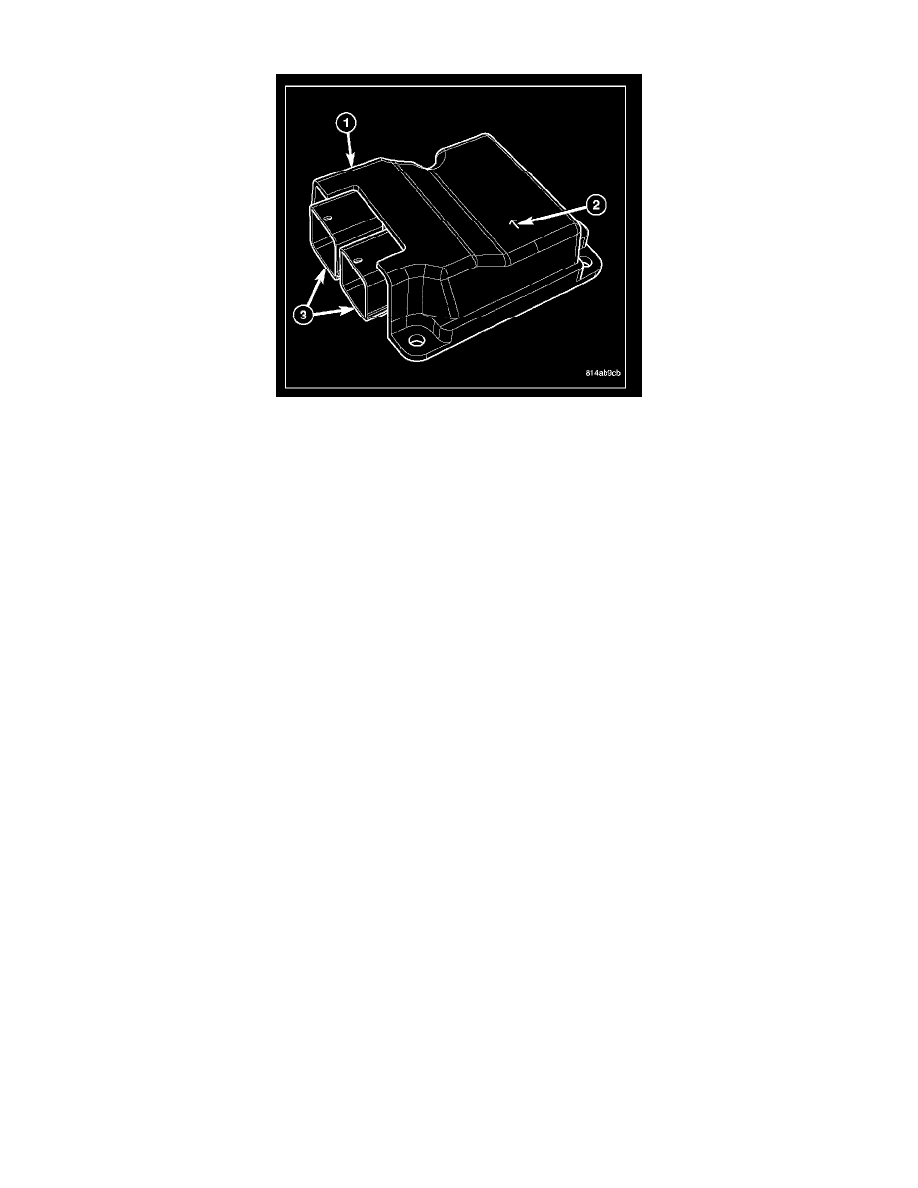Dakota 2WD V8-4.7L VIN J (2005)

Air Bag Control Module: Description and Operation
The Occupant Restraint Controller (ORC) (1) is located below the instrument panel center stack in the passenger compartment of the vehicle, where it is
secured by three nuts to three studs on a stamped steel mounting bracket welded onto the top of the floor panel transmission tunnel just forward of the
instrument panel center support bracket. Concealed within a hollow in the center of the die cast aluminum ORC housing is the electronic circuitry of the
ORC which includes a microprocessor, an electronic impact sensor, an electronic safing sensor, and an energy storage capacitor. A stamped metal cover
plate is secured
to the bottom of the ORC housing with screws to enclose and protect the internal electronic circuitry and components.
An arrow (2) printed on a label on the top of the ORC housing provides a visual verification of the proper orientation of the unit, and should always be
pointed toward the front of the vehicle. The ORC housing has three integral flanges with mounting holes. Two are on the corners oriented towards the
rear of the vehicle, and one is near the center of the side facing the front of the vehicle. A molded plastic electrical connector (3) with two receptacles,
each containing up to thirty-two terminal pins, exits the left facing side of the ORC housing. These terminal pins connect the ORC to the vehicle
electrical system through two dedicated take outs and connectors, one each from the instrument panel and the body wire harnesses.
The impact sensor and safing sensor internal to the ORC are calibrated for the specific vehicle, and are only serviced as a unit with the ORC. In addition,
there are unique versions of the ORC for vehicles with or without the optional side curtain airbags. The ORC cannot be repaired or adjusted and, if
damaged or faulty, it must be replaced.
The microprocessor in the Occupant Restraint Controller (ORC) contains the supplemental restraint system logic circuits and controls all of the
supplemental restraint system components. The ORC uses On-Board Diagnostics (OBD) and can communicate with other electronic modules in the
vehicle as well as with the diagnostic scan tool using the Controller Area Network (CAN) data bus. This method of communication is used for control of
the airbag indicator in the ElectroMechanical Instrument Cluster (EMIC) and for supplemental restraint system diagnosis and testing through the 16-way
data link connector located on the driver side lower edge of the instrument panel.
The ORC microprocessor continuously monitors all of the supplemental restraint system electrical circuits to determine the system readiness. If the ORC
detects a monitored system fault, it sets an active and stored Diagnostic Trouble Code (DTC) and sends electronic messages to the EMIC over the CAN
data bus to turn on the airbag indicator. An active fault only remains for the duration of the fault, or in some cases for the duration of the current ignition
switch cycle, while a stored fault causes a DTC to be stored in memory by the ORC. For some DTCs, if a fault does not recur for a number of ignition
cycles, the ORC will automatically erase the stored DTC. For other internal faults, the stored DTC is latched forever.
On models equipped with the Occupant Classification System (OCS), the ORC communicates with the Occupant Classification Module (OCM) over the
CAN data bus. The ORC will internally disable the passenger airbag and seat belt tensioner deployment circuits if the OCM detects that the passenger
side front seat is unoccupied or that it is occupied by a load that is inappropriate for an airbag deployment. The ORC also provides a control output to the
passenger airbag on/off indicator through the passenger airbag indicator driver circuit. The OCM notifies the ORC when it has detected a monitored
system fault and stored a DTC in its memory for any faulty OCS component or circuit, then the ORC sets a DTC and controls the airbag indicator
operation accordingly.
In club cab models, the ORC also monitors a resistor multiplexed input from the passenger airbag on/off switch. If the passenger airbag on/off switch is
set to the Off position, the ORC turns on the passenger airbag on/off indicator and will internally disable the passenger airbag and seat belt tensioner
from being deployed, regardless of the status of the input from the OCS.
The ORC receives battery current through two circuits; a fused ignition switch output (run) circuit through a fuse in the Junction Block (JB), and a fused
ignition switch output (run-start) circuit through a second fuse in the JB. The ORC receives ground through a ground circuit and take out of the
instrument panel wire harness. This take out has a single eyelet terminal connector that is secured by a ground screw to the left side of the floor panel
